



























MIDWEEK UPDATE 10 OCTOBER 2018
Plan Your Weekend……..Forthcoming Events…….Aviation News
Worldwide Incidents and Accidents……This Week in Aviation History


11: Frans Grotepas at the EAA Flying Legends Talk Show EAA Auditorium, Rand Airport. Contact Marie Reddy 083 259 7691
13 Stellenbosch Flying Club breakfast fly-in. For more information contact gm@stelfly.co.za or hone 021 880 0294



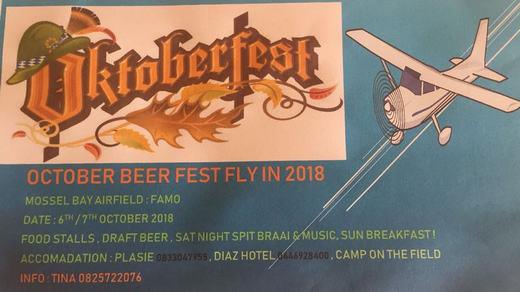
23 & 24: Avi Afrique 2018 Africa Aviation Innovation Summit CSIR. Contact ATNS Percy Morokane E-mail: percymo@atns.co.za
3rd Saturday of every month. Microland. Bring and braai. Fires and bykos provided. Fires start from 09h30. Contact person: Nick Swardt 082 441 8011 or Alan Hussey 072 82 2341
21: Military Art Exhibition CANSA Art Gallery, Menlyn Park Tswane. Contact Munnik Marais 083 268 8701
27: NAV Rally Baragwanath Airfield and lecture by Springbok Rally pilot Rob Jonkers. Contact Marie Reddy 083 259 7691


3: Potties Vliegklub MISASA Fly in. Contact Nico Willemse. nico@pottiesnuus.co.za 082 582 5961
3: Volksrust Breakfast Run. Free breakfast to all pilots and passengers. Hangar dance. To RSVP Whatsapp Robert 082 907 4917.
7: EAA Chapter 322 meeting. Dicky Fritz Moth Hall Edenvale. Contact: clive.king@tariff.co.za or kevinmarsden88@gmail.com
9-11: EAA Sun 'n Fun Brits Airfield. Contact Marie Reddy 083 259 7691
10: EAA Sun n Fun Adventure Rally - Brits. Contact Rob Jonkers e-mail: rob@aerosud.co.za Cell:082 804 7032
17: Aero Club of South Africa awards dinner 17h00 onwards. Contact E-mail: office@aeroclub.org.za
3rd Saturday of every month. Microland. Bring and braai. Fires and bykos provided. Fires start from 09h30. Contact person: Nick Swardt 082 441 8011 or Alan Hussey 072 82 2341
24: Springs Fun Rally - Springs Airfield. Free breakfast to all that fly in on the day. Not just rally participants. Contact e-mail: chairman@sapfa.co.za cell: 082 855 9435


1 to 2: Sport Aerobatics ACE of Base Brits Contact Annie Boon E-mail: chunge@mweb.co.za
5: EAA Chapter 322 meeting. Dicky Fritz Moth Hall Edenvale. Contact: clive.king@tariff.co.za and kevinmarsden88@gmail.com
3rd Saturday of every month. Microland. Bring and braai. Fires and bykos provided. Fires start from 09h30. Contact person: Nick Swardt 082 441 8011 or Alan Hussey 072 82 2341
8. WAA breakfast fly-in. RSVP comms@flywaa.co.za

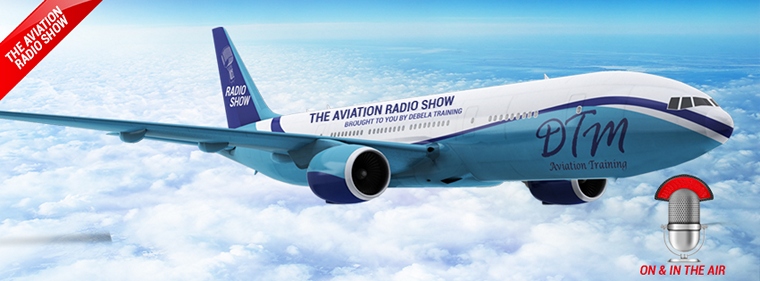
The Aviation Radio Show; get all your questions answered in one place. To listen to a recording of the live broadcast click on the link:
www.debela.co.za/aviation-radio-show


AERO CLUB SPECIAL GENERAL MEETING (SGM) 23 OCTOBER
Primarily as currently the Aero Club today is governed by Articles of Association, this is not as yet in line with the amended companies act of 2008, where a Memorandum of Incorporation (MOI) is the defining standard in terms of company registration. Thus, to rectify this, the plan is to bring into effect a suitable MOI and underpinned by a new Constitution which will replace the Articles of Association. The essential changes in the Constitution are mostly related to changes in the management structures and the fiduciary roles of the directors and council members, as well as defining more explicitly terms of office.
The draft documents are on the Aero Club website http://www.aeroclub.org.za/constitution-moi/ which also provides explanatory notes. The current Articles of Association are also available on the website. In order to bring these new set of Governance documents into effect, a Special General meeting (SGM) is to be called within the current 21 day notice period requirements, thus this communication serves to notify all members of the Aero Club that the SGM planned for this will take place on:
Date: 23 October
Time: 18h00
Venue: EAA Auditorium Rand Airport
If you have any comments / proposals related to this new set of Governance documents, please post these to office@aeroclub.org.za Should there be any material changes based on further inputs from members, this may affect the date, however, updates made will be communicated with further mailings with updated revisions of the documents uploaded on the website.
Best Regards
Rob Jonkers (Vice Chairman)

The AERO South Africa 2019 exhibition will be hosted at Wonderboom National Airport from 4-6 July 2019 and is poised to be Africa's largest general aviation trade show. The event will expose visitors to the latest advances, developments, products and services from exhibitors in the aviation industry.
From ultralights and gliders to business jets, helicopters and electric aircraft, as well as avionics and maintenance, companies will be afforded the opportunity to showcase their cutting-edge products and services.
AERO South Africa gives your company the opportunity to:
• Interact with industry professionals and buyers
• Generate new sales leads
• Nurture relationships and interact with your customers
• Create brand awareness
• Launch new products and services to the industry
Meet with leading industry experts, enthusiasts, aviation companies, flight training schools, pilots, business jet owners and private aircraft owners over 3 days of excitement, demonstrations and face-to-face business meetings.
What are the FOUR focus areas for AERO South Africa?
OPERATIONAL……………………………………………………………………..EXHIBITION
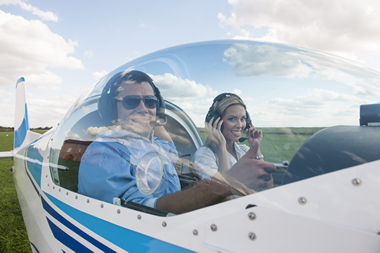

VISITOR ENGAGEMENT……………………………………………………….SHOW CONTENT
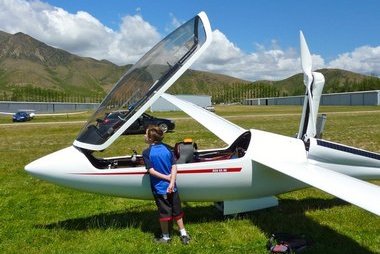
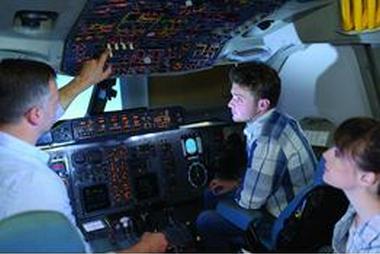
Interested in booking space at AERO South Africa?
Please feel free to get in contact with one of our team members below should you have any questions.
Shaun Swart | shaun.swart@za.messefrankfurt.com | +27 10 599 6167
Jan-Paul Nel | jp@aerosouthafrica.com | +27 82 511 6501


Premiums are hardening in the aviation insurance industry as capacity, both locally and abroad, is contracting. Although this is not great on the pocket at first, it will ultimately benefit clients says Reon Wiese, an aviation insurance specialist at PSG Insure, part of JSE-listed PSG Konsult.
Over the last 10 years, insurers have been adding aviation to their offerings and newer, smaller aviation brokerages have been offering cheap coverage. This resulted in a glut that drove premiums down to unprecedented and, in Wiese's opinion, unsustainable levels.
Wiese, an aircraft owner and pilot himself, admits that low aviation insurance premiums are attractive, especially considering the overall cost of this pursuit. "But while low premiums are attractive, what's more important is that your claim is ultimately settled as expected."
In the last couple of years insurance companies began realising losses from their aviation lines. "This wasn't as a result of increased claims, but rather due to premiums becoming unsustainably low, resulting in insurers losing money, says Wiese. Insuring a flight school with six or more aircraft for a minimal premium is good for the client in year one. However, claims will negate the premium with the first loss. Insurers then have no option but to substantially increase the next year's premium, failing which the sustainability of the insurance line is threatened.
As a result, a number of aviation insurance carriers started offloading their aviation books. In Wiese's view, this process is only halfway complete, particularly in the general aviation segment. In insurance parlance, airplanes with over 50 seats are classed as airlines, while those with less are classed as 'general aviation'.
Because prices were driven so low, increases will have to be fairly substantial going forward. Wiese says that in both general aviation and airline insurance, prices have already gone up between 10% and 15% depending on the insurer. "In both segments we expect similar increases for the next five years to bring premiums back to levels where clients are getting good coverage from reliable underwriters who, in turn, are able to settle claims and still make an appropriate profit," he says. To put the increases required to return to sustainable premium levels into perspective, it is worth noting that rates 10 years ago were more than triple compared to today's levels.
Claims in aviation insurance can be massive. Therefore, it's important that your insurance company has good credentials and your brokerage is able to service and support you to the expected standard.
"When smaller aviation insurers or brokers exit the market because they accepted the risk at an unsustainably low rate, they tend to leave behind unsettled claims with difficult reinsurance structures and no payment. Alternatively, the claims only get half-settled with the insurer refusing to pay the claim in full." This is clearly neither to the benefit of clients, nor the aviation industry.
South African law requires advisers to first try to place a policy in the local market. There are now only a handful of South African insurance companies that provide aviation insurance. PSG supports solid local companies with the risk they are comfortable in covering. Bigger risks are placed through a combination of syndicates within Lloyds of London and/or A-rated international insurers. "Risk sharing is a vital feature of aviation insurance," Wiese says.
PSG Insure has one of the biggest aviation insurance offerings in South Africa, and is the only brokerage that offers a full-service offering across all classes of short-term insurance (commercial and personal lines).


National Ultralight is delighted to announce the new Challenger Light Sport E Series. The new EL-65 is a long wing, two seat, high power, high lift aircraft well suited for amphibious floats, heavy loads and high density altitudes. Photo © Challenger.
The new ES-65 is a clip wing derivative of the EL-65 optimized for speed with a wing four feet shorter. The 582 powered EL-65 and ES-65 can carry impressive payloads while delivering outstanding STOL performance.
The EL-65 and ES-65 incorporate key improvements of the top of the line Light Sport X Series XL-65 and XS-65, at lower prices closely comparable to the earlier Challenger II models. In effect the predecessor Challenger II's capabilities are significantly uplifted without uplifting the cost.
The new models are powered by the bespoke Challenger 582 Power Pack which has been the number one choice of owners since 2005 The oil injected 582 has proven itself in over 10 years of real world use, delivering exceptional performance, excellent fuel economy and outstanding reliability in a wide range of terrains throughout the extremes of four season climates.
The new E Series models have the larger tapered vertical tail and differential ailerons of the XL-65 and XS-65. The result is easier, more conventional handling with much less rudder work, especially in turbulence. The new E Series also gets the XL/XS easy entry cabin. The windscreen, doors and cockpit side rails have been redesigned to make entry and exit much easier. The windscreen is moved 4.5 inches forward compared to previous Challenger II models. This gives more room for the pilot to enter the front seat.
The Challenger Light Sport XL-65 and XS-65 were originally designed expressly for diverse Canadian missions in a wide range of terrain and temperatures. Development was driven by over thirty years of real world experience on wheels, skis and floats. The XL-65 and XS-65 incorporate numerous features and design enhancements based on customer inputs.
The Light Sport E and X Series models expand the top end of the Challenger's envelope while retaining the trademark docile nature, low stall speed and great glide characteristics

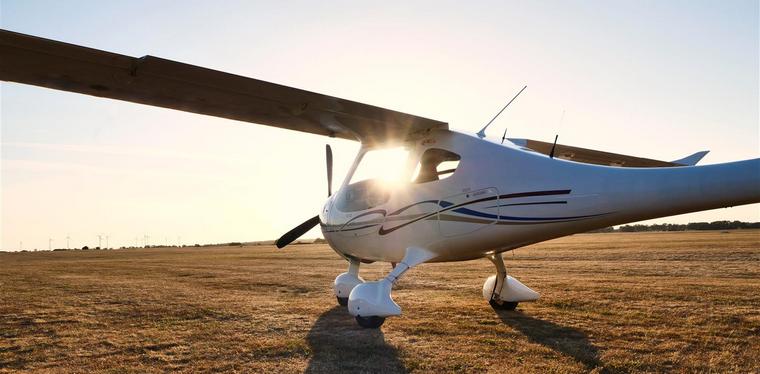
EASA has recently published the latest version of the EASA Basic Regulation which was voted upon by the European Union Parliament in June, 2018. A part of this new regulation now allows for 600 kg MTOW Ultralight (UL) aircraft under the control of the CAA's of the member states. Photo © CTSW.
With the publication of the Regulation, (EU) 2018/1139 will enter into use on 11, September 2018. The EASA member states are now allowed to 'opt-out' or choose to not require the more restrictive EASA regulations for aircraft with a maximum takeoff mass up to 600 kilograms.
Specifically, every member state must apply for an opt-out and can then have national rules for aircraft up to 600 kg. Several countries, like the Czech Republic, Germany, Italy and many others already declared that they will use this option.
Although the final rules for certification, service, pilot licences etc. are not yet available, they are anticipated soon. In Germany it is expected that rules will be much like the existing rules for Ultralight aircraft.
The staff at Flight Design general aviation is already working on the compliance for our existing fleet. We expect that the major part of the existing fleet can comply with the new 600 kg rules with some compliance verification, supplemental changes and an upgrade to a 600 kg rescue system. More to come soon!


Zunum Aero, a pioneer in electric aviation, selected Safran Helicopter Engines for its hybrid-to-electric commercial aircraft, which will be available in the early 2020s. Safran Helicopter Engines will provide a new generation engine turbine to drive the Zunum ZA10's electrical generator. Photo © Zunum.
This turbo-generator will power this 12-seat, hybrid-to-electric 700-mile commercial aircraft, driving extraordinarily low operating costs, offering unprecedented door-to-door travel times that are 2 to 4 times faster than today. Zunum expects to light up thirty thousand airports around the world with frequent and affordable air service.
The Zunum aircraft under development, internally dubbed the ZA10, is the first in the company's family of regional, hybrid-to-electric aircraft. It will be powered by dual power sources: propulsion batteries, and a Safran turboshaft from the 1,700 to 2,000 shaft horsepower (shp) Ardiden range.
This new model, the Ardiden 3Z, will be used as a hybrid power source achieving demanding cost, efficiency and uptime requirements. It will be coupled with an electric generator, and the integrated turbo-generator will deliver 500kW of electric power to supplement the battery packs on key stages of flight and over long ranges. Upgrades such as advanced materials and integrated lifecycle management for hybrid service will dramatically reduce operating costs of the engine by extending the life of critical components.
The new aircraft will deliver breakthrough operating costs of 8 cents per available seat mile or $250 per hour for the aircraft, which is 60-80 percent lower than comparable conventional aircraft of comparable size. The ZA10 aircraft is designed to cruise and land on turbo-generator power alone, offering full redundancy.
Near-term milestones include ground and flight testing scheduled for 2019, as well delivery of the ZA10 aircraft targeted for the early 2020s.


"Today's announcement is the culmination of years of unwavering focus by the Boeing and Saab team," said Leanne Caret, president and CEO, Boeing Defence, Space & Security. "It is a direct result of our joint investment in developing a system centred on the unique requirements of the U.S. Air Force. We expect T-X to be a franchise program for much of this century." Photo © Boeing/SAAB
Boeing and its risk-sharing partner Saab designed, developed, and flight tested two all-new, purpose-built jets ? proving out the system's design, repeatability in manufacturing and training capability.
"This selection allows our two companies to deliver on a commitment we jointly made nearly five years ago," said Håkan Buskhe, president and CEO of Saab. "It is a major accomplishment for our partnership with Boeing and our joint team, and I look forward to delivering the first trainer aircraft to the Air Force."
Boeing is now clear to begin placing orders with its suppliers, including Saab. More than 90 percent of Boeing's offering will be made in America, supporting more than 17,000 jobs in 34 states.
Saab serves the global market with world-leading products, services and solutions within military defense and civil security. Saab has operations and employees on all continents around the world. Through innovative, collaborative and pragmatic thinking, Saab develops, adopts and improves new technology to meet customers' changing needs.


US, Marine Corps Air Station Beaufort: The U.S. military suffered its first crash of an F-35 aircraft in the 17 year history of the high-profile fighter jet program. The crash of the Marine Corps variant of the F-35, known as the F-35B Lightning II, occurred Friday at 11:45 a.m. outside Marine Corps Air Station Beaufort in South Carolina. The U.S. Marine pilot safely ejected. The aircraft, which cost more than $100 million, belonged to Marine Fighter Attack Training Squadron 501, which trains Marine pilots for combat with the F-35.

USA, Type: Owyhee County between Reynolds Creek and Silver City: A Cessna 210T operated by T and C Aircraft Corp with three and a canine onboard impacted mountainous terrain in Owyhee County. The airplane sustained unreported damage. None of those onboard survived.
USA, Brackett Field Airport: The pilot of a Beechcraft V35 Bonanza on approach to the airfield clipped a tree and impacted terrain near Brackett Field Airport in La Verne, California. The aircraft was consumed by the post-impact fire. The pilot did not survive the crash.
Canada, Winnipeg: An Air Canada Airbus A320-200 on a flight from Winnipeg, MB to Toronto, ON was climbing through FL200 on autopilot when the flight crew noticed the aircraft showed a 5 degrees left bank and right rudder input. The crew disconnected the autopilot but needed to apply the same left roll and right rudder input in order to maintain heading in manual flight. The crew decided to return to Winnipeg and landed safely about 40 minutes after departure. The Canadian TSB reported maintenance identified a faulty rudder trim actuator and replaced it.
Russia, Ostrovets, Moscow: A Mig-29 of the Russian Air Force with two onboard crashed in a forest. Both occupants ejected safely. The aircraft was damaged beyond repair.

USA, close to Hefner-Easley Airport: Following a loss of engine power shortly after take-off from Hefner-Easley Airport Wagoner, Oklahoma, a Cessna 206 with only the pilot onboard did a forced landing . The airplane sustained substantial damage and the sole pilot onboard received unspecified injuries.
Russia, near Vonyshevo: A Eurocopter AS 350B3 Écureuil private helicopter crashed into tree, killing all three on board, including the Deputy Prosecutor General of the Russian Federation. All four occupants, the pilot and three passengers, died in the crash. The aircraft was consumed in the post-crash fire.


Kathryn D. Sullivan becomes the first American woman to perform spacewalk aboard the Space Shuttle Challenger.

Sullivan performed the first extra-vehicular activity (EVA) by an American woman during Space Shuttle Challenger mission STS-41-G on 11 October 1984. Sullivan and mission specialist David Leestma performed a 3.5-hour spacewalk in which they operated a system designed to show that a satellite could be refuelled in orbit. During their eight-day mission, the crew deployed the Earth Radiation Budget Satellite, conducted scientific observations of the earth with the OSTA-3 pallet (including the SIR-B radar, FILE, and MAPS experiments) and large format camera (LFC), conducted a satellite refuelling demonstration using hydrazine fuel with the Orbital Refuelling System (ORS), and conducted numerous in-cabin experiments as well as activating eight "Getaway Special" canisters. STS-41G completed 132 orbits of the Earth in 197.5 hours, before landing at Kennedy Space Centre, Florida, on 13 October 1984.
Sullivan left NASA in 1993. She flew on three space shuttle missions and logged 532 hours in space.

 |
 |
 Copyright © 2024 Pilot's Post PTY Ltd
The information, views and opinions by the authors contributing to Pilot’s Post are not necessarily those of the editor or other writers at Pilot’s Post.
Copyright © 2024 Pilot's Post PTY Ltd
The information, views and opinions by the authors contributing to Pilot’s Post are not necessarily those of the editor or other writers at Pilot’s Post.